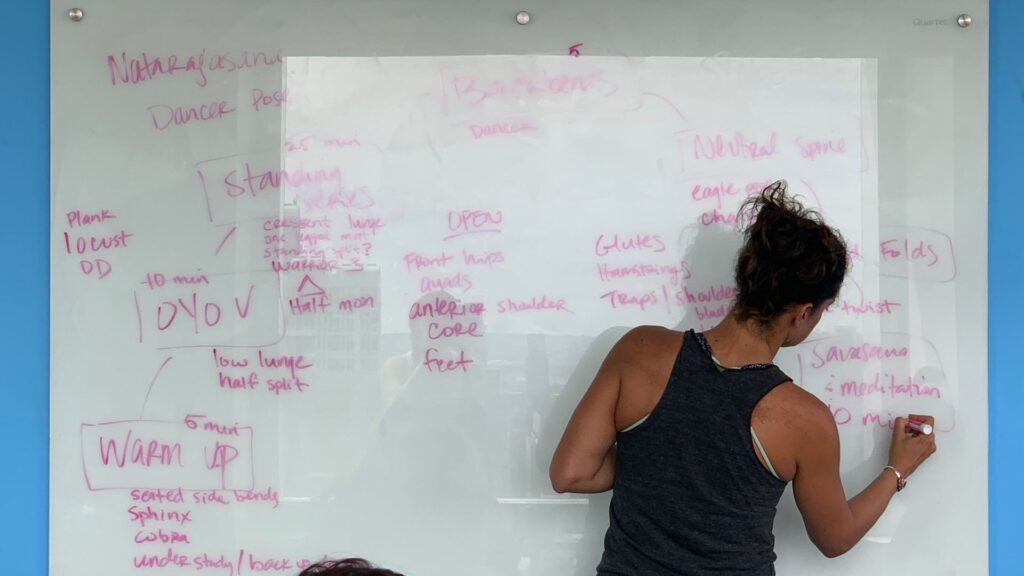Language and Cueing Alternatives for Teaching Corporate Yoga

Interested in teaching corporate yoga? Learn more!
We’ve all been in that class where the teacher asks us to open our third eye and connect to the collective unconscious. Better yet, we’ve probably been that teacher. Although yoga language may fly in a studio setting, it’s the quickest way to lose your audience in an office environment. Adapting language and cueing when teaching corporate yoga involves tailoring your communication style to suit your audience. When you sign up for Office Yoga Teacher Training, you’ll see an entire chapter dedicated to alternative language and cueing styles. Today, I want to share some quick tips to amend your cues when teaching corporate yoga.
To OM or not to OM
This is the fastest way to make your corporate yogis uncomfortable. The vibration of OM may have its benefits, but not in an office yoga setting. Consider, instead of OM, that students take a deep breath in through their nose and open mouth exhale. This serves a similar purpose without the discomfort of making noise in the office and disrupting coworkers who are not practicing in class.
Use Business-Friendly Language
Business-friendly language doesn’t mean saying “circle back” to the second side in Cresent Lunge. It means speaking in layman’s terms. Opt for clear and straightforward words easily understood by individuals with varying backgrounds. Avoid using overly spiritual language or wordy anatomical terms. If possible, relate yoga principles to everyday workplace challenges, such as focus, contentment, discipline, or non-greed, without overtly using Sanskrit.
Emphasize Practical Benefits
Working with the chakras and energetic body is common in a yoga studio but not in a corporate yoga class. Avoid intangible cues like “feeling a golden light of energy run up the spine and out the crown chakra.” Instead, consider “feel the spine lengthen upward like steam rising.” Highlight the tangible benefits of yoga relevant to a corporate setting, such as better posture and increased resilience, which can be particularly beneficial in high-pressure work environments.

Be the first to receive Office Yoga tips and inspiration here!
Avoid Partner Poses
Although in-office yoga can be a team-building experience, coworkers generally don’t want to touch each other during class. Instead, foster a sense of community within the corporate yoga class by pacing the group to move and breathe together or storytelling.
Name the Pose First
Chances are there is one yogi in the group, and the rest are beginners. Name the post first and then cue the positioning after. The yogi in the group will know what to do, and others will naturally follow. This is a good rule of thumb for teaching in general, but especially when you have a mixed group with mostly beginner-level students.
Cue the Room, Not the Earth
When a teacher cues me to reach my arms “up to the sky” or “feel the earth beneath my feet,” I immediately feel like they’re not with me. Feeling the earth beneath your feet is hard in dress shoes or heels. Unless you are teaching outdoors, cue the body position to the room you are in. In Desk Yoga, I often reference the table’s edge for hand and foot placement. “Stand next to the table with your hips parallel to the edge of the desk. Place your palms flat on the table, shoulder distance apart. Step your feet back, creating an L shape in the body,” is an easy way to get people into a Desk Yoga version of downward dog without unnecessary jargon.

Follow us for more corporate yoga inspiration!
A Thing About Modifications
Recognize that participants may have different levels of experience and flexibility. In Desk Yoga, employees practice in their work clothes, adding another obstacle to their range of motion. Provide modifications for poses based on employees’ range of motion and wardrobe. Create an inclusive environment where everyone, regardless of their slacks and high heels, can feel comfortable participating.
Encourage Feedback for Adaptation
Feedback is a common practice in the corporate environment and provides excellent insight to develop your skills. Encourage feedback from employees and be open to adapting your teaching style based on their preferences and needs. Each company is unique, so stay flexible and responsive to the different dynamics of each corporate group.
Job stress is one of the leading causes of poor health and injury, and yoga can be an effective remedy if implemented correctly. Language and verbal cueing are essential areas to adapt when teaching in the office. By combining traditional yoga principles with a business-friendly approach, you can create a yoga program that is accessible and beneficial for individuals at work.
Office Yoga Teacher Training provides a blueprint for teaching yoga in the workplace. Click here to learn more.
